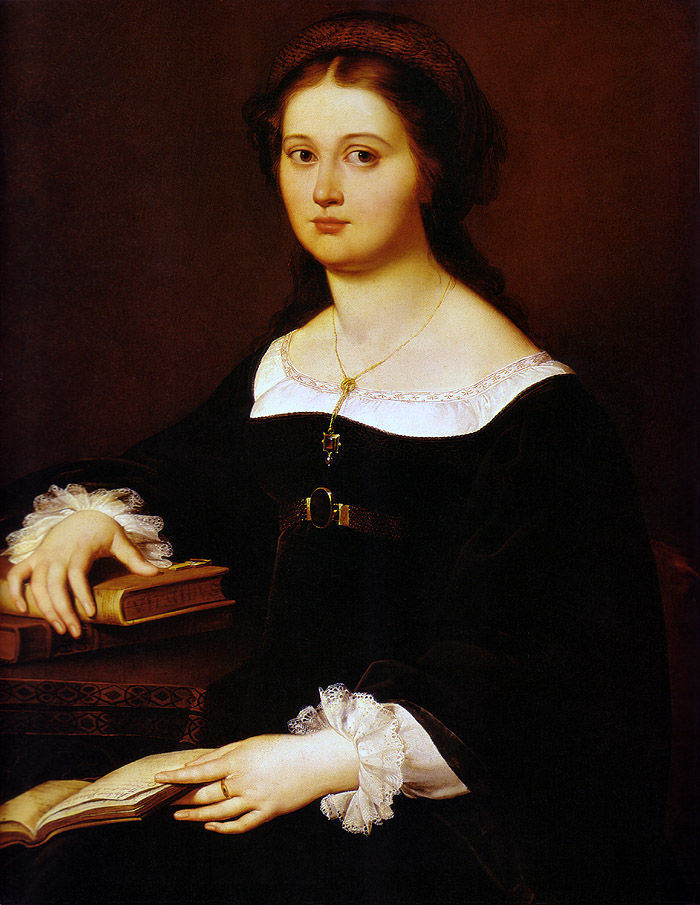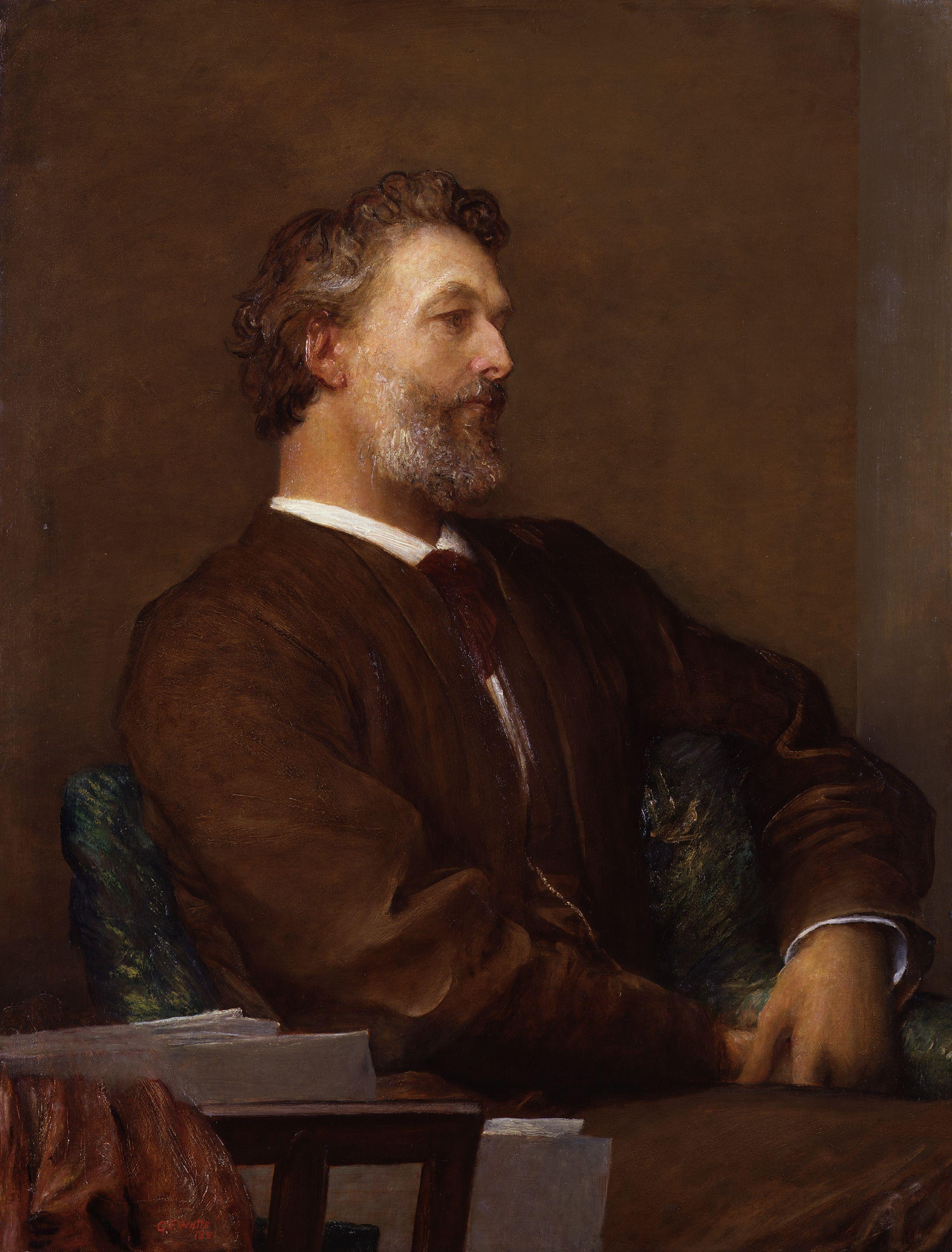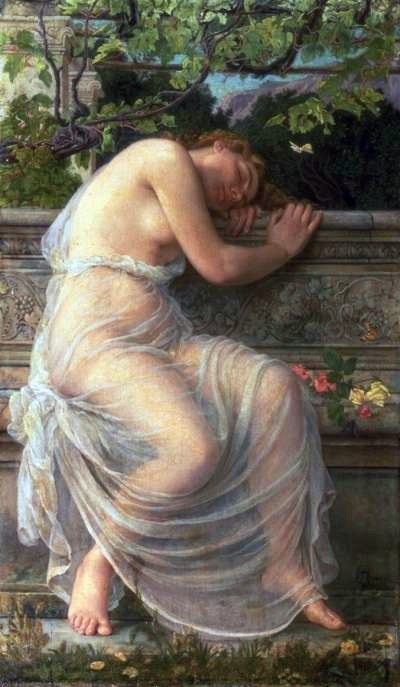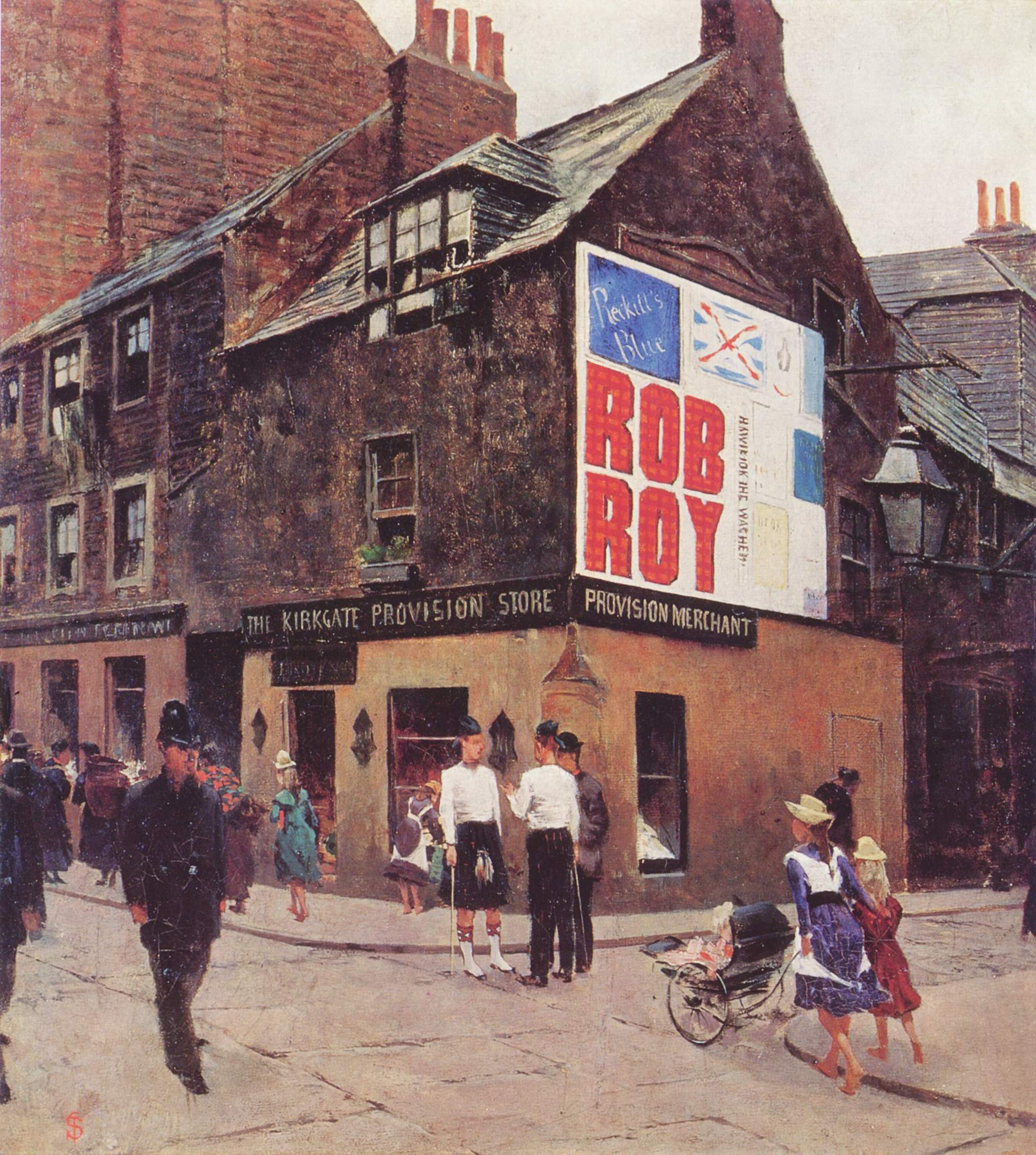|
Nino Costa
Giovanni Costa (15 October 1826 – 31 January 1903), often known as Nino Costa, was an Italian landscape painter and patriotic revolutionary. Biography Giovanni Costa was born in Rome on 15 October 1826, the fourteenth of the sixteen children of Gioacchino Costa (died 1842) and Maria Chiappi (died 1857). His father was from Santa Margherita Ligure and as a young man had moved to Rome, where he opened a wool-spinning factory and achieved wealth and position. The family lived in a large house in Piazza San Francesco a Ripa, in Trastevere, close to the factory. When he was 12 Giovanni was introduced to the neo-classical painter Baron Vincenzo Camuccini, who encouraged him to work from nature and from what he saw around him. Soon after was sent to the Jesuit college at Montefiascone, where remained for five years. Costa returned to Rome in 1843, the year after the death of this father, and for two years attended the Collegio Bandinelli in the via Giulia, founded by Bartolommeo ... [...More Info...] [...Related Items...] OR: [Wikipedia] [Google] [Baidu] |
Frederic Leighton
Frederic Leighton, 1st Baron Leighton, (3 December 1830 – 25 January 1896), known as Sir Frederic Leighton between 1878 and 1896, was a British painter, draughtsman, and sculptor. His works depicted historical, biblical, and classical subject matter in an academic style. His paintings were enormously popular, and expensive, during his lifetime, but fell out of critical favour for many decades in the early 20th century. Leighton was the bearer of the shortest-lived peerage in history; after only one day his hereditary peerage became extinct upon his death. Biography Leighton was born in Scarborough to Augusta Susan and Dr. Frederic Septimus Leighton (1799-1892), a medical doctor. Leighton's grandfather, Sir James Boniface Leighton (1769-1843), had been the primary physician to two Russian tsars - Alexander I and Nicholas I - and their families, and amassed a fortune while in their service. Leighton’s career was always cushioned by this family wealth, with his father pa ... [...More Info...] [...Related Items...] OR: [Wikipedia] [Google] [Baidu] |
Filippo Agricola
Filippo Agricola (1776–1857) was an Italian painter of the 19th century, mainly active in Rome. He was born at Urbino but trained in the Accademia di San Luca in Rome. He became that institution's president in 1843. He also became director of the mosaic factory of the Vatican. He worked mainly in Rome, painting for the churches of San Onofrio, San Giovanni in Laterano, and San Paolo fuori le Mura. He died during the time he was at work in the latter. He painted the portraits of the ''Crown Princess of Denmark'' (1822), and of the ''Countess Costanza Monti Perticari'' now found in the Galleria Nazionale d'arte Moderna in Rome. Agricola also painted a portrait of Lt General Sir Gordon Drummond while Drummond was convalescing in Rome from a gunshot wound received in the War of 1812 The War of 1812 (18 June 1812 – 17 February 1815) was fought by the United States of America and its indigenous allies against the United Kingdom and its allies in British North America, with li ... [...More Info...] [...Related Items...] OR: [Wikipedia] [Google] [Baidu] |
Tate Gallery
Tate is an institution that houses, in a network of four art galleries, the United Kingdom's national collection of British art, and international modern and contemporary art. It is not a government institution, but its main sponsor is the UK Department for Digital, Culture, Media and Sport. The name "Tate" is used also as the operating name for the corporate body, which was established by the Museums and Galleries Act 1992 as "The Board of Trustees of the Tate Gallery". The gallery was founded in 1897 as the National Gallery of British Art. When its role was changed to include the national collection of modern art as well as the national collection of British art, in 1932, it was renamed the Tate Gallery after sugar magnate Henry Tate of Tate & Lyle, who had laid the foundations for the collection. The Tate Gallery was housed in the current building occupied by Tate Britain, which is situated in Millbank, London. In 2000, the Tate Gallery transformed itself into the curre ... [...More Info...] [...Related Items...] OR: [Wikipedia] [Google] [Baidu] |
Frederick Leighton
Frederic Leighton, 1st Baron Leighton, (3 December 1830 – 25 January 1896), known as Sir Frederic Leighton between 1878 and 1896, was a British painter, draughtsman, and sculptor. His works depicted historical, biblical, and classical antiquity, classical subject matter in an Academic art, academic style. His paintings were enormously popular, and expensive, during his lifetime, but fell out of critical favour for many decades in the early 20th century. Leighton was the bearer of the shortest-lived peerage in history; after only one day his hereditary peerage became extinct upon his death. Biography Leighton was born in Scarborough, England, Scarborough to Augusta Susan and Dr. Frederic Septimus Leighton (1799-1892), a medical doctor. Leighton's grandfather, Sir James Boniface Leighton (1769-1843), had been the primary physician to two Russian tsars - Alexander I of Russia, Alexander I and Nicholas I of Russia, Nicholas I - and their families, and amassed a fortune while i ... [...More Info...] [...Related Items...] OR: [Wikipedia] [Google] [Baidu] |
Barbizon School
The Barbizon school of painters were part of an art movement towards Realism in art, which arose in the context of the dominant Romantic Movement of the time. The Barbizon school was active roughly from 1830 through 1870. It takes its name from the village of Barbizon, France, on the edge of the Forest of Fontainebleau, where many of the artists gathered. Most of their works were landscape painting, but several of them also painted landscapes with farmworkers, and genre scenes of village life. Some of the most prominent features of this school are its tonal qualities, color, loose brushwork, and softness of form. The leaders of the Barbizon school were: Théodore Rousseau, Charles-François Daubigny, Jules Dupré, Constant Troyon, Charles Jacque, and Narcisse Virgilio Díaz. Jean-François Millet lived in Barbizon from 1849, but his interest in figures with a landscape backdrop sets him rather apart from the others. Jean-Baptiste-Camille Corot was the earliest on the scen ... [...More Info...] [...Related Items...] OR: [Wikipedia] [Google] [Baidu] |
Jean-Baptiste-Camille Corot
Jean-Baptiste-Camille Corot ( , , ; July 16, 1796 – February 22, 1875), or simply Camille Corot, is a French landscape and portrait painter as well as a printmaker in etching. He is a pivotal figure in landscape painting and his vast output simultaneously referenced the Neo-Classical tradition and anticipated the plein-air innovations of Impressionism. Biography Early life and training Jean-Baptiste-Camille Corot was born in Paris on July 16, 1796, in a house at 125 Rue du Bac, now demolished. His family were bourgeois people—his father was a wig maker and his mother, Marie-Françoise Corot, a milliner—and unlike the experience of some of his artistic colleagues, throughout his life he never felt the want of money, as his parents made good investments and ran their businesses well. After his parents married, they bought the millinery shop where his mother had worked and his father gave up his career as a wigmaker to run the business side of the shop. The store ... [...More Info...] [...Related Items...] OR: [Wikipedia] [Google] [Baidu] |
Earl Of Carlisle
Earl of Carlisle is a title that has been created three times in the Peerage of England. History The first creation came in 1322, when Andrew Harclay, 1st Baron Harclay, was made Earl of Carlisle. He had already been summoned to Parliament as Lord Harclay (or Lord Harcla) in 1321. However, Lord Carlisle was executed for treason in 1323, with his titles forfeited. The second creation came in 1622, when James Hay, 1st Viscount Doncaster, was made Earl of Carlisle. He was a great favourite of James I and had already been created Lord Hay in the Peerage of Scotland in 1606, as well as Baron Hay, of Sawley in the County of York, and Viscount Doncaster in 1618. The latter titles were in the Peerage of England. Lord Carlisle was the member of a junior branch of the Hay family, headed by the Earl of Erroll. He was succeeded by his second but only surviving son, the second Earl. In 1637, he also succeeded his maternal grandfather, Charles Goring, 2nd Earl of Norwich, as second B ... [...More Info...] [...Related Items...] OR: [Wikipedia] [Google] [Baidu] |
Edith Corbet
Edith Corbet née Edenborough (28 December 1846 – 1920) was a Victorian landscape painter, having close associations with the Macchiaioli group (also known as the Tuscans or Etruscans), who, in a break with tradition, painted outdoors in order to capture natural light effects and favoured a panoramic format for their paintings. Life Edith Edenborough was born in Goulburn, New South Wales, Australia, the second daughter and fifth child of Henry Edenborough and Margaret Stedman. The Edenborough family came from Leicestershire, but relocated to London, where they became prosperous merchants in hosiery and silk. Henry Edenborough was a sea captain and made several voyages to Australia between 1833 and 1837, deciding to settle there in 1840. He acquired a farm south of Goulburn known as 'Wollogorang' and built "a handsome two-storey brick and stone rubble building notable for its interesting French windows and its impressive outbuildings". This was the family home until 1854 when ... [...More Info...] [...Related Items...] OR: [Wikipedia] [Google] [Baidu] |
Matthew Ridley Corbet
Matthew Ridley Corbet (20 May 1850 – 25 June 1902) was a Victorian neoclassical painter. Life Corbet was born on 20 May 1850 at South Willingham, Lincolnshire, was son of the Rev. Andrew Corbet and Marianne Ridley. He was educated at Cheltenham College. He attended classes at the Slade School of Art under Alexander Davis Cooper and later at the Royal Academy Schools under Frederic Leighton, President of the Academy. Corbet went to Italy in 1880 and met Giovanni Costa, one of Leighton's friends in Rome. For the next three years he stayed and painted with Costa, eventually becoming one of the leading figures of the Macchiaioli school. He concentrated on Italian landscapes and exhibited at the Grosvenor Gallery, the New Gallery, the Royal Academy and the Paris Salon. His ''Sunrise'' gained a bronze medal at the Paris Exhibition of 1889; and his ''Morning Glory'' (1894) and ''Val d'Arno Evening'' (1901), bought under the terms of the Chantrey Bequest, are now in the ... [...More Info...] [...Related Items...] OR: [Wikipedia] [Google] [Baidu] |
Elihu Vedder
Elihu Vedder (February 26, 1836January 29, 1923) was an American symbolist painter, book illustrator, and poet, born in New York City. He is best known for his fifty-five illustrations for Edward FitzGerald's translation of ''The Rubaiyat of Omar Khayyam'' (deluxe edition, published by Houghton Mifflin). Biography Elihu Vedder was born February 26, 1836 in New York City, the son of Dr. Elihu Vedder Sr. and Elizabeth Vedder. His parents were cousins. His father, a dentist, decided to try his luck in Cuba, and this had a profound impact on Elihu Jr.'s childhood. The remainder of his childhood was spent between his maternal grandfather Alexander Vedder's house in Schenectady and a boarding school. His mother supported his goals to be an artist while his father reluctantly assented, convinced that his son should try a different occupation. His brother, Dr. Alexander Madison Vedder, was a Navy surgeon who witnessed the transformation of Japan into a modern culture while he was stati ... [...More Info...] [...Related Items...] OR: [Wikipedia] [Google] [Baidu] |
Macchiaioli
The Macchiaioli () were a group of Italian painters active in Tuscany in the second half of the nineteenth century. They strayed from antiquated conventions taught by the Italian art academies, and did much of their painting outdoors in order to capture natural light, shade, and colour. This practice relates the Macchiaioli to the French Impressionists who came to prominence a few years later, although the Macchiaioli pursued somewhat different purposes. The most notable artists of this movement were Giuseppe Abbati, Cristiano Banti, Odoardo Borrani, Vincenzo Cabianca, Adriano Cecioni, Vito D'Ancona, Serafino De Tivoli, Giovanni Fattori, Raffaello Sernesi, Silvestro Lega and Telemaco Signorini. The movement The movement originated with a small group of artists, many of whom had been revolutionaries in the uprisings of 1848. In the late 1850s, the artists met regularly at the Caffè Michelangiolo in Florence to discuss art and politics. These idealistic young men, dissatisfied ... [...More Info...] [...Related Items...] OR: [Wikipedia] [Google] [Baidu] |
Florence
Florence ( ; it, Firenze ) is a city in Central Italy and the capital city of the Tuscany region. It is the most populated city in Tuscany, with 383,083 inhabitants in 2016, and over 1,520,000 in its metropolitan area.Bilancio demografico anno 2013, datISTAT/ref> Florence was a centre of medieval European trade and finance and one of the wealthiest cities of that era. It is considered by many academics to have been the birthplace of the Renaissance, becoming a major artistic, cultural, commercial, political, economic and financial center. During this time, Florence rose to a position of enormous influence in Italy, Europe, and beyond. Its turbulent political history includes periods of rule by the powerful Medici family and numerous religious and republican revolutions. From 1865 to 1871 the city served as the capital of the Kingdom of Italy (established in 1861). The Florentine dialect forms the base of Standard Italian and it became the language of culture throughout Ital ... [...More Info...] [...Related Items...] OR: [Wikipedia] [Google] [Baidu] |



_(2).jpg)








